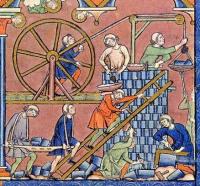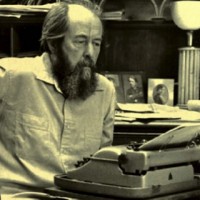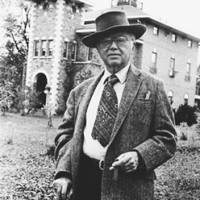Anno Mille, la paura che non fu, by Marco Respinti
La fine del mondo non è adesso, lo abbiamo visto. I cristiani, come insegnava Gesù, non si preoccupano dell’ora e del giorno, ma preparano costantemente lo spirito per il momento della risurrezione, vivendo sempre operosamente la vita come un tempo ultimo, cioè definitivo e decisivo. Ma il contrario esatto di ciò insegna invece la cultura moderna a partire almeno dall’illuminismo, ovvero quell’epoca di disgregazione sistematica del senso della verità delle cose che ha preteso di riscrivere daccapo e a propria immagine e somiglianza la storia dell’uomo, inventandosi per esempio categorie funzionali come quella di “Medioevo”.
Dall’illuminismo in poi, il “Medioevo” è servito come capro espiatorio di ogni nefandezza o sciocchezza allo scopo di distrarre l’attenzione dai veri responsabili, cioè quelle molteplici “scuole del sospetto” (le ideologie, i relativismi, i nichilismi) che in questo modo hanno potuto proliferare e fare scempi. Uno dei cavalli di battaglia di questa falsificazione della realtà è il presunto oscurantismo generato dallo spirito della religione che la Chiesa Cattolica avrebbe appositamente alimentato per dominare gli uomini e che i vari poteri politici avrebbero volentieri favorito sperando in un condominio. Dunque i “medioevali” – dice la falsificazione illuminista – credevano a tutte le scempiaggini che preti e frati s’inventavano per tenerseli buoni; per esempio alla fine tutte le cose prodotta dalla venuta dell’Anticristo nell’anno Mille.
Sta del resto scritto ne l’Apocalisse che, dopo mille anni di cattività alla catena dell’arcangelo san Michele, Satana sarebbe stato liberato per spadroneggiare finché Cristo, tornando per la seconda e definitiva volta, non avrebbe posto fine ai suoi disastri e stabilito la giustizia per sempre: «Vidi poi un angelo che scendeva dal cielo con la chiave dell’Abisso e una gran catena in mano. Afferrò il dragone, il serpente antico – cioè il diavolo, satana – e lo incatenò per mille anni; lo gettò nell’Abisso, ve lo rinchiuse e ne sigillò la porta sopra di lui, perché non seducesse più le nazioni, fino al compimento dei mille anni. Dopo questi dovrà essere sciolto per un po’ di tempo» (Ap 20, 1-3).
Ora, che i “medioevali” abbiano vissuto atterriti gli ultimi anni prima del Mille lo sappiamo tutti. Lo sappiamo tutti perché di questi e di altri oscurantismi dell’“età buia di mezzo” tutti abbiamo letto. Dove? Difficile ricordarsene. Certamente comunque non in libri di storia fatti come tale disciplina comanda. Perché in realtà le paure dell’anno Mille nei testi veri non ci sono. È solo una colossale montatura.
Parte di questo falso mito potrebbe peraltro basarsi su quel mai sopito, e in realtà solo rimandato, senso della fine imminente che pervadeva i primissimi cristiani, alcuni persino testimoni diretti della predicazione di Gesù. Per loro, il ritorno di Cristo poteva, legittimamente, sembrare cosa imminente; ma poi i Padri della Chiesa, abili sistematori di ottima dottrina, dissiparono il campo dalle illazioni e dalle facili suggestioni – pur ritenute vere da certuni in buona, ottima fede –, ricordando che lo stesso Gesù definisce vano il voler interrogare le stelle circa l’ora e il giorno della fine, nonché peccato l’insistervi.
Si dice che la fantomatica paura “medioevale” dell’anno Mille sarebbe stata salmodiata dalle labbra di sin troppo facili profeti, nella formula «mille e non più mille», che sarebbe un “detto di Gesù”. Ma Gesù non lo ha mai detto. E così nel Mille non accadde proprio alcunché, nessuno si spaventò sul serio e la falsificazione della storia ha dovuto essere riscritta una volta in più, rimandando la data al “più mille”. Il “Medioevo”, ancora, non c’entra affatto.
Che quella delle paure della fine del mondo “tipiche” nell’anno Mille sia in realtà solo una falsa leggenda costruita assai più tardi, cioè nei rinascimentali Annali detti di Hirsau (1511-1513), e questo precipuamente per gettare disprezzo sull’Alto “Medioevo”, venendo in seguito rilanciata in grande stile dal Romanticismo ottocentesco, lo illustra con rigore uno specialista del calibro dello storico francese Georges Duby in un paio di bei libri, quali L’Anno Mille. Storia religiosa e psicologia collettiva (trad. it. Einaudi, Torino 2001) e Mille e non più Mille. Viaggio tra le paure di fine millennio (con Chiara Frugoni, trad. it., Rizzoli, Milano 1999). Un solo scritto “medioevale” parla infatti di eventi strabilianti e inquietanti avvenuti nel Mille, il Chronicon (o Chronographia) del monaco benedettino Sigebert di Gembloux, che descrive il periodo tra il 381 e il 1111: ma è un testo del secolo XII. Parecchio successivo al Mille. Al massimo, cioè, Sigebert riporta, riferisce, copia notizie di altri. Il forte sisma del Mille di cui parla nel suo Chronicon quel buon monaco lo trae per esempio dagli Annales Leodienses, ma le fonti delle sue altre “notizie”? E per di più Sigebert tace completamente dei presunti terrori che si sarebbero diffusi nella popolazione cristiana del “Medioevo” all’avvicinarsi del Mille. Per trovarne le prime tracce occorre appunto attendere il secolo XVI.
Read the complete article in La nuova bussola quotidiana
Solzhenitsyn: The Courage to be a Christian, by Joseph Pearce.
In these dark days in which the power of secular fundamentalism appears to be on the rise and in which religious freedom seems to be imperiled, it is easy for Christians to become despondent. The clouds of radical relativism seem to obscure the light of objective truth and it can be difficult to discern any silver lining to help us illumine the future with hope.
In such gloomy times the example of the martyrs can be encouraging. Those who laid down their lives for Christ and His Church in worse times than ours are beacons of light, dispelling the darkness with their baptism of blood. “Upon such sacrifices,” King Lear tells his soon to be martyred daughter Cordelia, “The gods themselves throw incense.”
It is said that the blood of the martyrs is the seed of the Church and, if this is so, more bloody seed has been sown in the past century than in any of the bloody centuries that preceded it. Tens of millions have been slaughtered on the blood-soaked altars of national and international socialism in Europe, China, Cambodia and elsewhere. Today, in many parts of the world, millions upon millions are being slaughtered in the womb in the name of “reproductive rights.”
In such a meretricious age the giant figure of Alexander Solzhenitsyn emerges as a colossus of courage. Born in Russia in 1918, only months after the secular fundamentalists had swept to power in the Bolshevik Revolution, Solzhenitsyn was brainwashed by a state education system which taught him that socialism was just and that religion was the enemy of the people. Like most of his school friends, he enslaved himself to the zeitgeist, became an atheist and joined the communist party.
Serving in the Soviet army on the Eastern Front during the Second World War he witnessed cold blooded murder and the raping of women and children as the Red Army took its “revenge” on the Germans. Disillusioned, he committed the indiscretion of criticizing the Soviet leader Josef Stalin and was imprisoned for eight years as a political dissident.
While in prison, he resolved to expose the horrors of the Soviet system. Shortly after his release, during a period of compulsory exile in Kazakhstan, he was diagnosed with a malignant cancer in its advanced stages and was not expected to live. In the face of what appeared to be impending death, he converted to Christianity and was astonished by what he considered to be a miraculous recovery.
Throughout the 1960s Solzhenitsyn published three novels exposing the secularist tyranny of the Soviet Union and received the Nobel Prize for Literature in 1970. Following the publication in 1973 of his seminal work, The Gulag Archipelago, an exposé of the treatment of political dissidents in the Soviet prison system, he was arrested and expelled from the Soviet Union, thereafter living the life of an exile in Switzerland and the United States. He finally returned to Russia in 1994, after the collapse of the Soviet system.
In 1978, Solzhenitsyn caused great controversy when he criticized the secularism and hedonism of the West in his famous commencement address at Harvard University. Condemning the nations of the so-called free West for being morally bankrupt, he urged that it was time “to defend not so much human rights as human obligations.”
Read the complete article in Crisis Magazine
Russell Kirk on Cultivating the Good Life, by Bruce Frohnen
When Russell Kirk passed away he was surrounded by his loving family, in the house he built on his ancestral land. This was fitting for a man who always wished to lead a life of “decent independence.” He had sought to provide for his family while remaining free from compromising entanglements. He did not want gratitude to some benefactor to cloud his judgment or tempt him to defend the “Permanent Things” with less than his full vigor.


